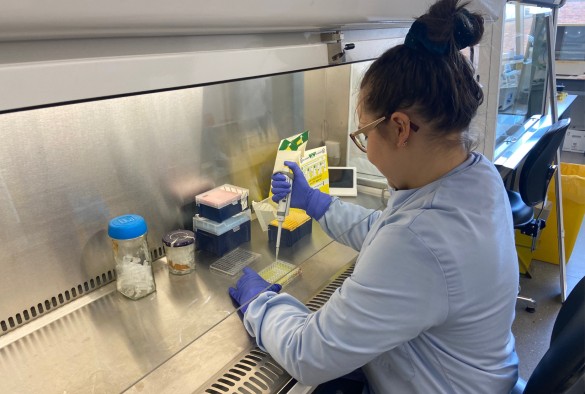
Danielle Brain is a fourth year PhD student and Research Associate in the Immunocompatibility Group, associated with the Centre of Excellence for Long-Acting Therapeutics (CELT). Her PhD is funded by the National Institutes of Health and her supervisors include Dr Neill Liptrott, Professor Andrew Owen and Professor Steve Rannard.
Long -acting drug formulations
Long-acting drug formulations, and long-acting injectables (LAI), are becoming increasingly common due to their ability to improve adherence to chronic treatment regimes, for example in the treatment of HIV and schizophrenia. The intention is to have these LAI slowly releasing the therapeutic for a number of weeks, providing coverage for times when a dose may be missed.
However, the immune system is an expert in recognising such new materials and formulations as originating from outside the human body, particularly as a lot of their characteristics are ‘alarms’ to the immune system, and can mount a response to them. This can result in two broad problems – an adverse reaction to the LAI, which raises safety issues, and the immune system can attempt to ‘hide’ these LAIs in a granuloma so that they do not cause any further inflammation. Granulomas can alter the release of the drug from the LAI, making it less effective. So, it’s important to determine the long-term biocompatibility of these formulations and materials so we can enhance our knowledge of how the immune system responds to long-term exposure to therapeutics so they can successfully be used as treatment for diseases such as HIV
My research
During my PhD, I examined how novel formulations of the HIV drugs FTC, TAF and 3TC interacted with the human immune system – using existing methods established by the group and also developing new models including a new 3D co-culture system and incorporating transcriptomics and proteomics.
I found that the drugs themselves did alter some immune responses, particularly over extended periods of time but, importantly, the new formulations were not that different from the free drugs. This was a really interesting finding as there is little data on long-term immune effects to these drugs but, importantly for the project, the new formulations didn’t raise any red flags.
At the moment, I am following up on some interesting findings around complement activation an writing a number of manuscripts based on my work.
The science is really interesting and challenging as the formulations are state-of-the-art and as such haven’t been examined in this way before. I was really pleased that parts of this work were recently awarded 2nd Prize in the Nanotoxicology and Nano-Bio-Characterisation category for a poster submitted to the CLINAM conference, in Switzerland. I was really proud of my achievement, as the judges of this category are internationally recognized experts in the field and recognized the novel nature of the work, and the potential impact on the field.
Outside of the lab
During my PhD, I have been involved in a number of sports. I enjoy taking trips in the UK hiking and climbing, as well as indoor bouldering. Since the pandemic I took up hockey again and now compete for Mossley Hill Hockey Club Ladies 1s team. Most notably I competed as part of the Gold Medal-winning Great Britain Women’s Team at the 2019 European Canoe Polo Championship in Coimbra, Portugal and the Gold Medal Winning FOA Liverpool Team at the 2018 European club championships in Nottingham. I also enjoy reading, whilst looking after my vast houseplant collection!
Future plans
Alongside writing up my thesis, I am now working as a Research Associate on a Higher Education Innovation Fund project working to determine the influence of patient, immunological, genetic variability on response to long-acting therapeutic formulations. As part of this work I am continuing to develop a 3D subcutaneous, in vitro model which I started to develop as part of my PhD lab work. This model will help better replicate the in vivo environment and aid the biocompatibility assessment of long-acting formulations in the future. It is the first of its kind, and could support the development of LAIs for future applications. We have already had some discussions with industry as to how this could be integrated into their development pipeline, and with international standards organisations on how it could be the basis of a future harmonised method. This is really exciting as it would be a large impact, beyond the ‘usual’ publications and has potential consequences for the development of novel long-acting drugs and devices, that could have a life changing impact on patients taking these drugs. Following my PhD I plan to continue in the field of immunocompatibility research, in the group, with more of a focus on nucleic acid therapeutics (NATs).